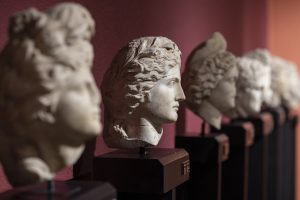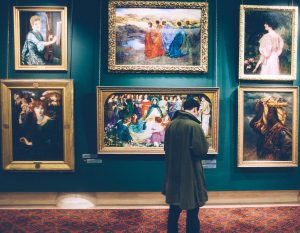
When choosing an adventure for my Hyperlinked Environments post, I opted into focusing on Libraries and Museums. Or, museum like exhibits within libraries. When looking at Kristine Clark’s article “Tacoma’s Museums: Filled with Life, Not Just Objects”, it points out that not only are the objects within the museums are coming to life but the idea of each object holding a memory and how we preserve these memories are of importance as well (Clark, 2018). This past weekend, I had the pleasure of visiting the New York Public Library (NYPL) for the first time as I was there for a night concert and was able to explore during the day. When thinking about Hyperlinked Environments, specifically museums, it is important to note that these environments will be accessible, engaging, and build communities.
Immediately upon walking into the library, I could tell that it was relevant to this assignment elaborating on Hyperlinked Environments based on the exhibits that they were offering in person and online. Although I was able to see it, it was accessible to those that are not within proximity to the library exhibit. I grabbed a brochure which explained what was in the Polonsky Exhibition of The New York Public Library’s Treasures and also how to access digital content if I felt it was necessary. I feel a connection to Clark’s article because there was such a sense of how amazing it truly is that the NYPL has dedicated time, energy, and effort into restoring and preserving these materials so that thousands of people can experience the exhibits day in and day out.

The materials that I saw on display are important to our history in many ways. A real photograph of Martin Luther King Jr. was on display which was just amazing to see in person. I know that MLK Jr. was a real person. I know that he has had a huge impact on society but until Friday, I had only seen images through books and online. Relating it to the University of Melbourne article “How does learning happen in museums?” – a quote from the very first paragraph describes how museums are purposefully designed spaces which mean learning happens “almost accidentally” (Oliveira, Barba, 2018). To see a real black and white photograph with an excerpt about the photographer and MLK Jr. himself from the day he marched was just surreal. It is a hard feeling to explain but so important to understanding the past and the future.
There were other materials and subjects explored such as women’s textiles/work, religious beliefs, and historical events documented. One of my favorite exhibits was the original Winnie the Pooh (also know as Mr. Edward Bear!) and other stuffed animals. I am a big Disney lover and I have never seen these materials in real life. I have also not studied the history of the dolls so it was fun to learn that too. The material was easy to access and easy to understand. It also brought a sense of joy to see these historical dolls on display in such good condition due to the care of the library and archival staff. Here is the audio guide from the NYPL website so you can hear about what I saw at the NYPL.

Photo of Winnie-the-Pooh and Friends exhibit, photo by me.
Another exhibit that I enjoyed was The Birds of America; from original drawings by John James Audubon. Audio guide found here. This exhibit was interesting (not pictured, the large book that the art was shown in) because it explained why the author made the art the way he did. In an attempt to make the artwork come to life, he created life size portraits of birds. The book was around 2.5 feet tall. I personally feel as though his influence shines through artwork of birds today as this photo seems familiar even though I had never seen it before. The audio guide is a useful tool for someone that is unable to access the content otherwise whether auditory or physically.

Photo of The Birds of America by John James Audubon exhibit, photo taken by me.
Lastly, although there were a few more exhibits (Visibility & Resistance, Byron: A Life in Motion, Line & Thread: Prints & Textiles from the 1600s to Present) that I saw, I only photographed a few things in the Polonsky Exhibit because I was just so in awe at all of the other collections. To my surprise, I was able to log onto a computer today and see everything that I had seen on Friday (and more). Outside of the exhibits I was able to physically visit, there are also online exhibits that anyone can access at all times. By allowing patrons to participate in these exhibits, you are breaking down barriers and walls for those that can not otherwise access them. There were also QR codes throughout the library where you could access history and audio guides.
Overall, I know that this is a small reflection on a truly expansive topic but I felt that my real life experience was a great way to immerse myself in the hyperlinked environment. Again, looking through the learning and how it happens in museums article, each museum has a goal when patrons come to visit. I feel as though my experience in the NYPL was Hedonic (seeking fun or passive enjoyment) and Social (wanting to communicate and share their experience with others) (Oliveira, Barba, 2018). Although this may be my own experience, there are other people who may have taken different experiences from the exhibit and that is fine and acceptable. Overall, the museum had in place learning opportunities, experiences, and ways to connect online afterwards, which made it a great hyperlinked experience for me and I am sure many others.
Included are links of different exhibits you may be interested in learning about as well as being able to explore the digital exhibit:
Line & Thread: Prints and Textiles from the 1600s to the Present
Virtual Exhibition: Price & Privacy: LGBTQ+ Visibility in Library Collections
References:
Clark, K. (2018). Tacoma’s Museums: Filled with Life, Not just Objects. Western Museums Association. https://westmuse.org/articles/tacoma%E2%80%99s-museums-filled-life-not-just-objects
Exhibitions. The New York Public Library. (n.d.). https://www.nypl.org/events/exhibitions
Oliveira, E. A., & Barba, P. de. (2024, July 10). How does learning happen in museums?. Pursuit by the University of Melbourne. https://pursuit.unimelb.edu.au/articles/how-does-learning-happen-in-museums

@crlhayd This was so interesting — especially having returned from Scotland with memories of six different museums I visited. There were so many amazing experiences provoked by art or by interaction with objects, or a display. I so appreciate all the ways we can extend our visits and participate! )I came very close to becoming a “friend” of the National Gallery of Scotland – I loved it so much!)
Yes – NYPL has me thinking of it, still, days later. I can’t wait to go back and explore again with my family. I always try to go to museums when I am visiting new places and sometimes my friends think it is funny that I work in a library and always navigate to a library even on my day off.
I also am thinking about visiting Philadelphia Fabric Workshop and Museum in November. I went there last November and we spent a lot of time in the city but also exploring – this is the exhibit that will be up as of tomorrow – https://fabricworkshopandmuseum.org/exhibition/soft-cover/.
The textile museum was a great experience and I was amazed at all of the artwork and the history quite literally weaved within the fabric of the exhibits.
This was the exhibit that I got to see last fall – it was quite fun and interactive as we could ‘yell’ into an orb and it danced to our voices. My daughter really liked it but the woven rugs were amazing to see in person. https://fabricworkshopandmuseum.org/exhibition/jessica-campbell-heterodoxy/
Hi @crlhayd – Loved your post. I am very drawn to spaces like this that blur the boundary between library and museum. I enjoyed your discussion of how the space made your own knowledge of MLK junior somehow more real– that is such a powerful experience and difficult to describe.
Thank you! It was a fun time. I love all that the city has to offer.
@crlhayd Thanks for this post! I love the idea of extending our visits after we physically leave an exhibition or collection. I studied for a few years at the School of the Art Institute of Chicago, which has an amazing encyclopedic collection (second in the US only to the Met!). As students we had free access to the museum, but there was no way to see everything, even on repeated visits over the years. For one thing, there is just so much of the collection that is not on view at any given time. During COVID I discovered this Chrome browser extension — https://chromewebstore.google.com/detail/art-institute-of-chicago/abacageipbknolldcoehafgfjamoejad — which shows me a different item from the collection every time I open up a new window or tab to Google something. It’s a great way to stay connected to a very special place and to continue exploring a collection I love from far away.
Cheers!
Arthur
Hi Carlee,
Your experience at the NYPL sounds incredible! I wish I had visited the library when I had the chance, especially the Polonsky Exhibition, which your description made it sound so enticing! I can’t imagine how amazing and impactful it must have been to see historic artifacts like the MLK photograph and the original Winnie the Pooh up close like that.
I also appreciate how you connected it to the idea of hyperlinked environments and the way museums, even within libraries, can offer such immersive, intricate experiences for both viewers on and off line. Thanks for sharing this—definitely adding it to my list for when I visit New York next time!
@crlhayd It is so incredible that NYPL has these exhibits on display for everyone to see free of charge. Many do not get to experience the magic and education of museums due to the cost of museums or not knowing how to access the information for financial help to get in. This is very inspiring and I’m sure sparks a lot of patrons’ creativity.